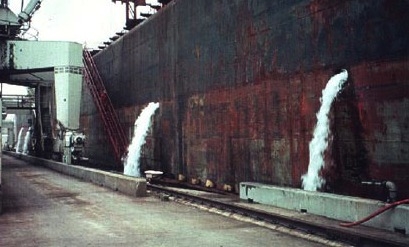
Vessels traveling on Lake Superior that are required to obtain the U.S. EPA vessel general permit must apply for the Minnesota ballast water general permit and comply with state rules and statutes. The permit covers both oceangoing and Great Lakes-only vessels. Applicants must provide a ballast water and sediment management plan and keep records of ballast activities.
The EPA permit covers more than 25 specific discharge categories, including deck runoff, bilge water, water from cooling and firemain systems, chain locker effluent, and gray water. Minnesota’s permit only covers ballast water discharges, which are by far the largest in volume. Ships routinely take on and discharge ballast water to stabilize the ship's weight due to fuel loading and use, cargo loading and unloading, and adverse weather conditions. Ships take on ballast water from many different places, and it may contain aquatic invasive species. The goal of the Minnesota permit is to prevent this transfer of invasive organisms.
Applying online is the fastest way to get your permit.
If you are paying permit fees from a foreign bank, apply using these forms:
2018 Minnesota ballast water general permit
Vessel owners must apply for the state general permit and pay permit fees as soon as they know their vessels will be entering Minnesota waters, at least 180 days before entering Minnesota waters. If vessel routes are not known 180 days in advance, applications should be submitted as soon as possible so the vessel can obtain permit coverage before entering Minnesota waters.
- If a ballast water and sediment management plan (BWSMP) has previously been approved by the MPCA and has not been modified since approval, permittees may check the box on the application form stating this instead of submitting a new copy. For voyages that originate outside the exclusive economic zone (EEZ), ensure that your BWSMP includes ballast water exchange if you have installed a ballast water treatment system.
- An original “wet” signature must be included on the submitted permit application if a hard copy is submitted rather than applying through the e-Services portal.
Permit application fees and annual fees can be paid electronically using the MPCA's e-Services portal, if paying by credit card (Visa or MasterCard) or electronic EFT (checking or savings account) from a participating bank based in the United States.
Additional Minnesota specific requirements for vessels with treatment systems:
- Vessels are required to conduct ballast water exchange regardless of the installation of a treatment system if the vessel’s voyage originated outside the EEZ. This activity must be stated in your Ballast Water and Sediment Management Plan (BWSMP).
- Vessels are required to report chemical additives use and may require chemical additive approval by the MPCA depending on the type of chemicals used in treatment and discharged. Please review the requirements and follow the procedures in the guidance and calculator documents. Get helpful tips and see a demonstration of the calculator in the videos linked below.
Permit change or termination
The permittee must submit a termination request when a vessel no longer requires coverage. The MPCA does not terminate permits without a termination request. This may occur at any time and facilities are responsible for fees while the permit is active.
The vessel discharge permit is a 10-year permit based on the issuance date of the General Permit and not by each vessel’s Notice of Coverage. The annual fee is $345 and the issuance/reissuance fee is $1240. Vessels planning to return to Minnesota waters within three years of receiving coverage will find financial benefit in keeping their permit ($345*3 years=$1,035) instead of terminating and reapplying for $1,240.
Vessels with permit coverage
Resources
Federal
- Ballast Water Management Program (U.S. Coast Guard)
- Invasive Species (U.S. EPA)
- Incidental discharge permitting (U.S. EPA)
- Vessel Incidental Discharge Act (U.S. EPA)
State-based
- Aquatic Invasive Species (Michigan Dept. of Environmental Quality)
- Ballast Water Program (Michigan Dept. of Environmental Quality)
- Invasive Species (Wisconsin Dept. of Natural Resources)
- Invasive species program (Minnesota Dept. of Natural Resources)
- Marine Invasive Species Program (California State Lands Commission)